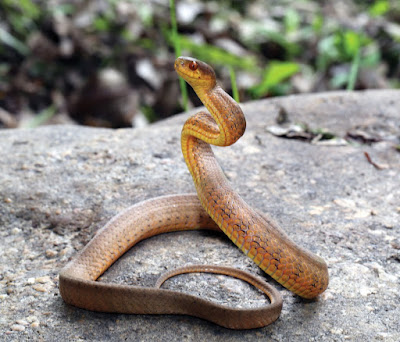 |
| Pareas menglaensis
Wang, Che, Liu, Li, Jin, Jiang, Shi & Guo, 2020
|
Abstract
The Asian snail-eating snakes Pareas is the largest genus of the family Pareidae (formerly Pareatidae), and widely distributed in Southeast Asia. However, potential diversity remains poorly explored due to their highly conserved morphology and incomplete samples. Here, on basis of more extensive sampling, interspecific phylogenetic relationships of the genus Pareas were reconstructed using two mitochondrial fragments (cyt b and ND4) and two nuclear genes (c-mos and Rag1), and multivariate morphometrics conducted for external morphological data. Both Bayesian Inference and Maximum Likelihood analyses consistently showed that the genus Pareas was comprised of two distinct, monophyletic lineages with moderate to low support values. Based on evidences from molecular phylogeny and morphological data, cryptic diversity of this genus was uncovered and two new species were described. In additional, the validity of P. macularius is confirmed.
Keywords: Molecular, morphology, new species, snakes, southeast Asia, systematics
Pareas menglaensis sp. nov.
Diagnosis: (1) prefrontal separating from orbit; (2) three chin-shield pairs, anterior pair smaller than other two; (3) 9–13 rows of mid dorsal scales keeled; (4) three rows of mid dorsal scales enlarged; (5) single loreal, not bordering orbit; (6) two preoculars, 2–3 suboculars, single postocular; (7) 9–11 temporals (3+3+3, 3+4+4, or 3+4+3); (8) seven supralabials, not bordering orbit; (9) 7–8 infralabials; (10) 3–5 maxillary teeth; (11) cloaca undivided; (12) dorsal scales in 15 rows throughout; (13) 176–177 ventral scales; (14) 65–79 subcaudals, paired.
Etymology: The specific species is named after the type locality, Mengla County, Yunnan, China. We suggest the common name “Mengla Snail-eating Snake” in English and “Mengla Dun-tou-she” (勐腊钝头蛇) in Chinese.
Distribution: This species is currently known only from the type locality Mengla County, Yunnan, China, with low mountain evergreen broad-leaved forest and a tropical monsoon climate type. It is expected to be found in the surrounding low mountainous areas and in neighboring Laos and Myanmar.
 |
| Figure 5. Holotype of Pareas mengziensis sp. nov. (YBU 14252). Dorsal (A) and ventral (B) of general views; dorsal (C), ventral (D), and lateral (E) views of the head. |
Pareas mengziensis sp. nov.
Diagnosis: (1) solid black marking on back of head extending along whole dorsal of body; (2) single preocular; (3) postocular fused with subocular; (4) loreal not bordering orbit; (5) temporals 2+3+3; (6) prefrontal bordering orbit; (7) three rows of mid dorsal scales slightly enlarged; (8) 3–7 rows of mid dorsal scales keeled; (9) 6–7 supralabials; (10) 8–9 infralabials; (11) 6–7 maxillary teeth; (12) cloaca undivided; (13) ventral scales 167–173; (14) subcaudals 54–61, paired.
Etymology: The new species is named after the type locality Mengzi City, Yunnan Province, China. We suggest the common name “Mengzi Snail-eating Snake” in English and “Mengzi Dun-tou-she (蒙自钝头蛇)” in Chinese.
Distribution: This species is currently known only from the type locality Mengzi City, Yunnan, China, in deciduous broad-leaved forest with a subtropical monsoon climate. It is expected to be located in the surrounding plateau regions.
Ping Wang, Jing Che, Qin Liu, Ke Li, Jie Qiong Jin, Ke Jiang, Lei Shi and Peng Guo. 2020. A Revised Taxonomy of Asian Snail-eating Snakes Pareas (Squamata, Pareidae): Evidence from Morphological Comparison and Molecular Phylogeny. ZooKeys. 939: 45-64. DOI: 10.3897/zookeys.939.49309



